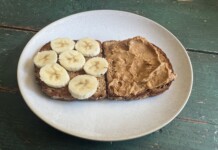By Nancy Clark MS RD CSSD, Copyright July 2011
The American College of Sports Medicine (ACSM) is the world’s largest organization of sports medicine and exercise science professionals. At ACSM’s annual meeting in Denver, May 31-June 4, 2011, over 6,000 exercise scientists, sports dietitians, physicians and other health professionals gathered to share their research. Here are a few of the nutrition highlights. More highlights are available at www.acsm.org (click on news releases).
Looking for a way to get fit quickly? High intensity interval training (HIIT) is effective, though it’s hard work! Once you are fit, you can then reduce the exercise intensity to a more enjoyable (sustainable) level. Dr. Martin Gibala of McMaster University in Ontario does not believe HIIT is a heart attack waiting to happen, but recommends untrained people first get a proper medical check-up.
HIIT can be an effective part of a weight reduction program. Overweight men who did twenty minutes of HIIT (8 second sprints with 12 seconds recovery) 3 times per week for 12 weeks achieved a 7% drop in body fat. In another study with untrained, slightly overweight women ages 30-45, those who did high intensity exercise lost more weight and body fat than those who did lower intensity training. One benefit of high intensity exercise is it can suppress the appetite (temporarily) compared to lower intensity exercise.
HIIT can create a significant afterburn. Men who expended roughly 500 calories during 47 minutes of vigorous exercise continued to burn 225 extra calories in the next 18.5 hours.
When athletes lose weight, they lose muscle as well as fat. For example, soldiers during nine weeks of combat training lost 9 lbs (4.2 kg) body weight, of which one-third was muscle loss and two-thirds fat loss. They consumed about 15% fewer calories than required to maintain weight.
Even bodybuilders and figure competitors do not lose just body fat when they lean out. In the 12 weeks pre-competition, male bodybuilders lost about 4 lbs (1.8 kg) lean body mass and 11.5 lbs (5.2 kg) body fat. The female figure competitors lost about 5.5 lbs (2.6 kg) lean and about 6.4 lbs (2.9 kg) fat.
Why do women struggle harder than men to lose undesired body fat? Perhaps because they are women! In the animal kingdom, female animals generate less body beat after overfeeding compared to the males. Research with humans suggests similar energy conservation. When four men and four women were overfed ice cream for three days (150% of energy balance needs), the men burned off some of the extra calories while the women conserved energy.
Should you believe the calorie estimates displayed on exercise machines? Doubtful. The Precor EFX556i overestimated energy expenditure, particularly with women.
A novel way to burn a few extra calories is to sit on a stability ball while you are at work. At a call center (where 90% of the time is spent sitting), the employees who sat on the stability ball for five hours during the workday burned about 260 more calories per eight-hour shift. Theoretically, that could lead to loss of 26 pounds in a year! They burned about half a calorie more per minute sitting on a stability ball than sitting in a chair. The biggest barrier to using the stability balls was aggravation of pre-existing back pain.
Trained cyclists who consumed equal calories of either a sports drink or banana chunks during a 75-kilometer cycling time trial performed similarly. The banana, however, offered a beneficial anti-inflammatory response. Natural foods generally offer more benefits than engineered sports foods.
Chocolate milk is a popular recovery food that contains carbohydrates to refuel muscles and high quality protein to build and repair muscles. Both full-fat and skimmed chocolate milk offer similar recovery benefits.
Beer is a plant-based beverage that offers anti-oxidant and anti-inflammatory properties. Marathoners who drank 1 to 1.5 liters of non-alcoholic beer per day for three weeks prior to a marathon and two weeks after the marathon experienced less post-race inflammation and fewer colds. Non-alcoholic beer offers a wise way to enjoy the natural high of exercise along with positive health benefits.
Have you ever wondered how much elite endurance athletes consume during an event? A post-event survey of Ironman triathletes, marathoners, long-distance cyclists, and professional bike racers suggests the Ironmen consumed about 70 grams (280 calories) of carbohydrate per hour; the cyclists, 53 grams (212 calories) and the marathoners, 35 grams (140 calories). The endurance athletes who consumed the most energy had the best performances.
How common are intestinal problems during endurance events? About 31% of the Ironman competitors reported GI serious problems, compared to 14% of the half-Ironman competitors, 4% of the cyclists, and 4% of the marathoners. Those with a history of GI distress reported the most symptoms, as well as those who exercised in higher heat.
If you are going to be competing in the heat, you might want to pre-cool your body. One way to do that is to enjoy an ice slurry. Runners who consumed about 14-ounces of ice slurry before they exercised in the heat were able to run about 1% faster during a 10 kilometer (6.2 mile) race.
Female athletes commonly restrict their food intake. Among 44 female high school cross-country runners (16 y.o.):
–39% restricted food, thinking being lighter would help them perform better.
–42% reported missed or absent menstrual periods in the past year-a sign of being under-fueled.
–They were eight times more likely to believe missing multiple periods was a sign they were in better shape.
These young women need to be educated about the medical problems associated with missed menstrual periods!
To resume menses, amenorrheic women need to correct the energy deficit. Those who drank a 360-calorie carbohydrate-protein supplement resumed menses, on average, in about 2.5 months (2 months). The longer they had been amenorrheic, the longer they needed to resume menses.









